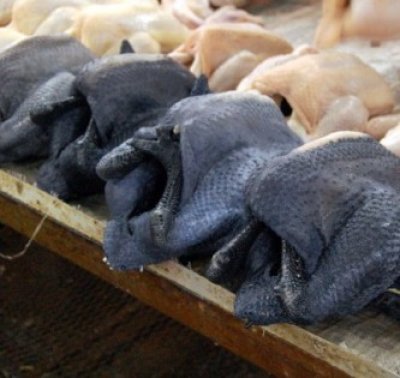There are black hens, with black skin and internal bodies
In China, there is a special species of rooster, the black-bone chicken Gallus gallus domesticus (var.) Linnaeus, of the Phasianidae family. The black-bone chicken is short, with a small head but a short neck. The black-bone chicken is originated in Taihe County, east of Wushan mountain in the Jiangxi province of China.
In China, depending on the location that the chicken is raised, it could be differentiated into different kinds, such as white-feather-black-bone, black-feather-black-bone, black-bone-black-meat, white-meat-black-bone, and so on. In other countries, the colors of the feathers are becoming much better in quality and has different variety through breeding. Other than the original white, nowadays one can spot it in black, blue, buff, grey and brown. 
When the Chinese leaders visited Thailand in 1983, they presented 20 eggs from the Jiangxi Taihe Wushan Original Chinese Farm as diplomatic gifts.
Taihe chicken is also favored as food. Its muscle fiber is fine and tender. Chicken soup made with it is tasty and refreshing. Its unique flavor makes it a special dish in a banquet. It could also make a precious medicinal dish when cooked with herbs. Why does the Taihe chicken has such outstanding nutritional and medical value? Research conducted by the Chinese Academy of Sciences shows that it is due to the peculiar natural conditions in Wushan, especially due to Wushan spring water which contains various minerals. It is said that the original silky fowls drink spring water, eat worms in the forest and wild grass there. There is a local saying that it is impossible to raise Wushan chicken without Wushan water.
To identify a black-bone chicken, just examine its tongue. A black tongue indicates it is a black-bone chicken. Researchers in poultry breeding and genetics have discovered that the unusual pigmentation in the black-bone chicken breed--in the skin, bones, connective tissues, muscles and tendons, and some other internal parts--is due to the combination of two genes.